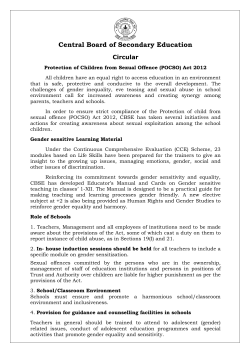
- Covenant University
Australian Journal of Social Science Research ISSN: 2203-9495 (Print) ISSN: 2203-9503 (Online) Influence of Family Structure on Adolescent Sexual Behaviour in Mushin Local Government Area of Lagos State, Nigeria Dr. Akanbi, Moses Ayokunle (Corresponding Author) Demography and Social Statistics Program Department of Economics and Development Studies Covenant University, Canaan Land, KM 10, Idiroko Road, P.M.B. 1023, Ota, Ogun State, Nigeria Mobile Phone number: +234-8032065341 E-mail: moses.akanbi@covenantuniversity.edu.ng Alternative E-mail: moseskemi2004@yahoo.com Gbadebo, Babatunde Makinde Department of Epidemiology and Medical Statistics Faculty of Public Health, College of Medicine, University of Ibadan, Oyo state, Nigeria Mobile Phone number: +234-08033678102 E-mail:tundegbadebo2005@yahoo.com Adekola, Paul Oluwatomipe Demography and Social Statistics Program Department of Economics and Development Studies Covenant University, Canaan Land, KM 10, Idiroko Road, P.M.B. 1023, Ota, Ogun State, Nigeria Mobile Phone number: +234-07032217871 E-mail: paul.adekola@covenantuniversity.edu.ng Olawole-Isaac, Adebanke Demography and Social Statistics Program Department of Economics and Development Studies Covenant University, Canaan Land, KM 10, Idiroko Road, P.M.B. 1023, Ota, Ogun State, Nigeria Mobile Phone number: +234-07039015597 E-mail: lovelybanke@yahoo.com Sowunmi, Akinyimika Demography and Social Statistics Program Department of Economics and Development Studies Covenant University, Canaan Land, KM 10, Idiroko Road, P.M.B. 1023, Ota, Ogun State, Nigeria Mobile Phone number: +234-09035259418 E-mail:sowunmiakinyimika@yahoo.com Godwin, Happiness Kelechi Demography and Social Statistics Program Department of Economics and Development Studies Covenant University, Canaan Land, KM 10, Idiroko Road, P.M.B. 1023, Ota, Ogun State, Nigeria Mobile Phone number: +234-08075956597 E-mail:daughterofliberty96@yahoo.com Abstract The study investigates the influence of family structure on adolescent sexual behaviour in Mushin Local Government Area of Lagos State, Nigeria. The research was conducted by taking a sample of 330 adolescents who are 15-24 years. The analytical techniques used in the study are: univariate, bivariate and chi-square tests. The key findings of this study are: firstly, there are two types of family structures identified which include: in-tact and divorced families. Secondly, that the in-tact (at p=0.000) has significant influence on adolescent sexual behaviour. Thirdly, at p=0.000, it was observed that divorced family has significant effect on adolescent sexual behaviour. The recommendations for this study are that there is urgent strong counsel for folks in Nigerian society at large to shun divorce and value marriages thereby having more intact-homes which will curtail to a large extent immoral sexual behaviour among the adolescents. Key Words: Adolescent, Family structure, Sexual behaviour Australian Society for Commerce Industry & Engineering www.scie.org.au 1 Australian Journal of Social Science Research ISSN: 2203-9495 (Print) ISSN: 2203-9503 (Online) 1. Background to the Study Studies have shown that the influence of parents in the upbringing of their children in certain ways of life cannot be over emphasised. In-fact, a study showed that 40-85 percent of children will get involved in some sexual behaviour before turning thirteen years of age (Friedrich, 1991). Sexual behaviour of unmarried adolescents cannot be studied alone without looking at the way their parents brought them up. The way parents behave or their actions and the examples they show to their children have a great influence on the adolescents‟ sexual behaviour and development (Maccoby and Martin, 1983). Here, it is vital reiterate that a child‟s sexual behaviour is dependent on his/her stage of development. Obviously, the manifestation of this sexual behaviour is the child‟s right and it is up to both parents and adults to ensure that this right is respected. Nevertheless, a prominent study has clarified that children and adolescents with sexual behaviour problems have been opened to variety of family dysfunction that may impact on them the development of sexually inappropriate behaviour (Bentovim, 1998). It is equally important to note that the provision for healthy sexual development is premised on allowing the child to experience and learn about proper sexual activities of his/ her own age group. Essentially, the family structure has been theorized to have several benefits for children. For instance, children have easy access to biological parents, higher parental involvement, more enjoyable parentchild relationship, rare cases of disagreements between children and parents among the in-tact families (Acock and Demo, 1994). McLanahan and Sandefur (1994) argued that in-tact (two-parent) families create a system of checks and balances for parents to act in appropriate ways. Parents can put pressure on each other so as to spend time with their children. They can also have good relationship with their children and monitor each other‟s discipline of the children. Thus, the presence of two biological parents within the household enables each parent to care for their children and become more involved in the affairs. To be specific, the concern of how divorce affects children has been the subject of interest over the past years. Research has indicated that divorce has long-term effects on children. According to Whitehead (1993); adolescents do not recover after parental divorce and the chaos of the family can have longterm emotional effects on them. For instance, studies on divorce show that it is a life-altering experience for offspring who must bear the actions of their parents (Wallerstein & Lewis, 2004). Ofcourse, the immediate effects of single parents have been found in adolescent‟s wellbeing, especially when measured up to adolescents from intact families (Amato, 2000). No doubt, adolescents who have experienced parents‟ separation are more prone to a variety of problems ranging from emotional to academic (Hetherington & Stanley-Hagan, 1999). These emotional problems from single parents may present themselves in a form of sexual activity at an earlier age. Wallerstein and Lewis (2004); posited that girls who come from single parent families entered into sexual relationships at an earlier age than girls who came from in-tact families. In-fact, gender difference between children in a divorce plays a very vital role on how they adjust. Several studies have buttressed that boys react more differently than girls in divorced families. This implies that boys seem to face serious difficulties when their parents are not together as a result of divorce, separation, desertion, widower and widowhood. This challenge may lead to peers fights, withdrawal of adolescents from schools and social interactions (Blakeslee & Wallerstein, 1989). In United States of America, the highest proportions of families were headed by single parents because divorce is common with 34 percent in 1998, 22 percent in Canada, 20 percent in Australia and 19 percent in Denmark respectively. Due to increasing rate of single parenting in Denmark, a prominent study shows that children reared in single parent families do not fare well compared to those reared in two-parent families on the average regardless of their race, education or parental remarriage (Furstenberg & Kiernan, 2001). Another study also indicate that adolescents in single parent families are more likely to experience increased difficulties academically, emotionally, psychologically and in their behaviour (Amato, 1994). More importantly, evidence from United States of America indicated that the family structure is no longer characterized by the traditional two-parent structure due to increasing numbers of single parent household. However, it has been observed that some of the effects of changes in family structures may be negative or positive (Glick, 1984). Australian Society for Commerce Industry & Engineering www.scie.org.au 2 Australian Journal of Social Science Research ISSN: 2203-9495 (Print) ISSN: 2203-9503 (Online) Moreover, it is vital to note that adolescents living with both natural parents have been found less susceptible to pressure from friends to engage in deviant behaviour than those from single parent home (Steinberg, 1987). In-fact, a prominent study indicated that children are observed to receiving good nurturing when both parents are available to discharge their parental responsibilities (Kurtz et al, 1991). Another research advocated that lack of parental support was related to depression for teen males and females, but the association between depressive symptoms and sexual activity was much stronger for females than males. In-effect, inadequate support from parents also led to the propensity for alcohol use which was more strongly associated with early sexual activity of teen males than females (Whitbeck, Hoyt, Miller & Kao, 1992). At this juncture, it is interesting to note that the rates at which unmarried adolescent engage in sexual activities and unsanctioned reproduction has become serious concern across the globe (Strong et al, 2002). In developing countries, especially in Kenya, there is highest rate of single parent families in Africa. For instance, research has shown that an increasing number of Kenyan women are single parents because the majority of Kenyan men abandoned their traditional role as providers for their children. An array of factors which include: irresponsible fathers, peer pressure, and the struggle to cope with modernization are blamed for the trend in which 3 out of 10 Kenyan girls become pregnant before the age of 18 years. Nevertheless, premarital births are the major causes of single parenting in Kenya unlike other developing countries where unavoidable causes like death of spouse and divorce are high (UNICEF, 2006). Obviously, due to globalization and industrialization of our contemporary times, family lives have been disrupted with the rapid social change that came with globalization. In-fact, sexual activities among adolescents have been reported to be on the increase worldwide. Several studies in sub-Saharan Africa have also reflected high and increasing premarital sexual activities among adolescents (World Health Organization, 2001). In Nigeria, the existence of multi-culture has enabled parents to prefer western life which led to single parenting that has negative effect on children's psychosocial outcomes. This has also engendered serious concerns about the psychological adjustment of Nigerian children and youth (Nwadinigwe, 2000). Moreover, in Nigeria, there is high rate of divorce, separation, abandonment, unmarried couples, poverty and death of spouse. These are the contributing factors of single parenting in our country. To be specific, there are many behavioural problems among the adolescents that Nigerian society is contending with presently and such problems include: drug offences, assault and cult activities (Nnachi, 2003). No doubt, heterosexual activities are also linked with types of behavioural problems that are prevalent in our society today. These challenges are variously emphasised in the literature which include: sex abuse, sex offences, sexual misconduct, sexual immorality, sexual promiscuity and sexual maladjustment (Ndu, 2000). The study conducted by Ajidahun (2011) has also shown that there is a high level of sexual activities among Nigerian adolescents. Many of these activities include: having more than one sex partners, patronage of prostitutes (among the males), and masturbation when they lack access to opposite sex, lesbianism and homosexuality. Here, it is pertinent to note that the involvement of adolescents in delinquent activities is on rapid increase in Nigeria (Omoegun, 2004). As a result, a child with faulty socialization process at an early stage in life is more likely to be delinquent in later life. At this crucial point in time, the study on adolescents‟ sexuality is expedient due to the fact that the adolescents lack adequate care and affection from their families respectively. In-fact, these adolescents often receive misguided information from both peer groups and the media in Nigerian society. With cognisance of the afore-stated challenges, this recent study raised the following questions: Firstly, what are the types of family structures identified in the study area? Australian Society for Commerce Industry & Engineering www.scie.org.au 3 Australian Journal of Social Science Research ISSN: 2203-9495 (Print) ISSN: 2203-9503 (Online) Secondly, can we probably affirm that there is significant influence of in-tact/divorced family on adolescent sexual behaviour in the study area? Nevertheless, the study tries to bring into lime-light the influence of family structure on adolescent sexual behaviour in Mushin Local Government Area of Lagos State, Nigeria. 1.1 Methods and Materials Used in the Study The study comprises of 330 male and female adolescents within the age range 15-24 years. The study adopted a quantitative research method in capturing the influence of family structure on adolescent sexual behaviour in Mushin Local Government Area of Lagos State, Nigeria. The study area is Mushin; a town and a suburb of Lagos state. It is one of Nigeria's 774 Local Government Areas and its inhabitants are mostly Yoruba people. It had 633,009 inhabitants during the Nigeria‟s 2006 Census. Mushin is a prominent Suburb of Lagos state (Mainland) where most adolescents‟ engage in criminal activities and juvenile delinquencies such drug taking/abuse, premarital sexual activities, alcohol drinking, stealing/robbery, unruly behaviour, deadly fighting with sharp knifes and cutlasses, nastysmoking and illegal abortions as a result of unwanted pregnancies. The choice of the study area (Mushin) is however, premised on the afore-stated vices among both male and female adolescents. The sampling techniques adopted in this study are: purposive and simple random sampling. The purposive sampling is done by ensuring that only those respondents who belong to age-category 15-24 years were interviewed. The questionnaire interviews schedule of respondents were divided into three categories: those in secondary school, those in their usual place of residence and those found in churches. Here, the simple random sampling was carried out by selecting 200 respondents from secondary schools, 100 in their usual place of residence and 100 in different churches within the area of study. Out of 400 questionnaires that were administered to the respondents, only 330 of them were returned due losses of questionnaires in the field. The information obtained from questionnaire interviews were analyzed by using SPSS (Statistical package for social sciences) in order to establish the degree of relationship among the variables of interest. This research embraced univariate, bivariate and chi-square tests analyses. 1.1.1 Presentation of Tables and Interpretations Table 1: Percentage Distribution of Age, Sex and Education of Respondents Variables 10-14 15-19 20-24 Total Male Female Total No education Primary level Secondary level Post secondary Total Source: Field Survey, 2014 Frequency Age Category 17 185 128 330 Gender 166 164 330 Educational level 4 16 84 226 330 % 5.2 56.1 38.8 100.0 50.3 49.7 100.0 1.2 4.8 25.5 68.5 100.0 Table 1 reflects the age category, gender and educational level of respondents. The percentage distribution showed that 15-19 years (56.1 percent) and male respondents (50.3 percent) dominated the study. Obviously, a higher proportion of respondents acquired post-secondary education (68.5 percent) Australian Society for Commerce Industry & Engineering www.scie.org.au 4 Australian Journal of Social Science Research ISSN: 2203-9495 (Print) ISSN: 2203-9503 (Online) compared to their counterparts without education (1.2 percent), primary (4.8 percent) and secondary (25.5) qualifications respectively. Table 2: Percentage Distribution of Religious Affiliation, Ethnicity and Marital status of Respondents Variables Christianity Islamic Traditional Total Yoruba Igbo Hausa Others Total Single Married Total Source: Field Survey, 2014 Frequency Religious Affiliation 265 57 8 330 Ethnic Group 163 123 36 8 330 Marital Status 302 28 330 % 80.3 17.3 2.4 100.0 49.4 37.3 10.9 2.4 100.0 91.5 8.5 100.0 Table 2 shows the religious affiliation, ethnic-group and marital status of respondents. According to religious affiliation, Christianity (80.3 percent) dominated compared to their Islamic (17.3 percent) and Traditional worshippers (2.4 percent). The ethnic group showed that Yoruba (49.4 percent) are the major respondents compared to Igbo (37.3 percent), Hausa (10.9 percent) and others with 2.4 percent. In-fact, the marital status of respondents indicated that single (91.5 percent) dominated the study. Table 3: Percentage Distribution of family structure of Respondents Variables Family Structure In-tact families Divorced families No Response Total Frequency 138 186 6 % 41.8 56.4 1.8 100.0 330 Source: Field Survey, 2014 Table 3 displays the percentage distribution of family structure of respondents in the study. The in-tact families depict 41.8 percent while divorced families indicate 56.4 percent of respondents. To be specific, the family structure of respondents showed that divorced families (56.4 percent) dominated the study. Table 4: Relationship between Parental guidance and Adolescent with opposite sex Variables Yes No No Response Total Source: Field Survey, 2014 Frequency 171 152 7 330 % 51.8 46.1 2.1 100.0 Australian Society for Commerce Industry & Engineering www.scie.org.au 5 Australian Journal of Social Science Research ISSN: 2203-9495 (Print) ISSN: 2203-9503 (Online) Table 4 reflects the relationship between Parental guidance and Adolescent with opposite sex in the study. In essence, a slightly higher proportion of respondents (51.8 percent) were guided by their parents on relationships with opposite sex compared to their counterparts (46.1 percent) who were not guided by their parents in the study location. Table 5: Bi-variate relationship between family structure and adolescent sexual involvement Variables Adolescent sexual intercourse Family Structure Yes (%) No (%) Total 33 (25.2) 103 (54.2) 136 In-tact families 98 (74.8) 87 (45.8) 185 Divorced families Total 131(100.0) 190 (100.0) 321 Source: Field Survey, 2014 Table 5 reveals the bivariate relationship between family structure (in-tact/divorced families) and adolescent sexual intercourse in the study area. According to in-tact families, a major proportion of respondents (54.2 percent) were not involved in sexual intercourse compared to their counterparts (25.2 percent) who were involved in sexual intercourse. The probable reason might be that these categories of respondents are those guided by their parents on relationships with opposite sex as indicated in Table 4. This implies that there is a positive influence of in-tact families on adolescent sexual behaviour in the study. However, the divorced families depict that a higher proportion of respondents (74.8 percent) were involved in sexual intercourse compared to their counterparts (45.8 percent) who were not involved in sexual intercourse. Here, it can be deduced that divorced families have negative effect on adolescent sexual behaviour in the study area. Table 6: Chi-square tests on relationship between family structure and adolescent sexual involvement Value Df Asymp. Sig. Exact Sig. (2- Exact Sig. (1(2-sided) sided) sided) Pearson Chi- 26.743a 1 0.000 Square Continuity 25.567 1 0.000 Correctionb Likelihood 27.566 1 0.000 Ratio Fisher's Exact 0.000 0.000 Test Linear-by26.659 1 0.000 Linear Association No. of Valid 321 Cases Source: Field Survey, 2014 Table 6 reflect Chi-square tests on relationship between family structure and Adolescent sexual involvement in Mushin Local Government Area of Lagos state. It is necessary to note that the Chi square analysis was carried out by employing the independent variable (In-tact or divorced family) and the dependent variable (Adolescent sexual involvement). Obviously, when p=0.000, in-tact family has significant influence on adolescent sexual involvements in the study. The reason for this finding might be due to lack of adequate care and negligence of adolescents by their parents. Most parents in the study area are too busy with their jobs and trading activities. Hence, they hardly had time to communicate and pay attention to the peer-pressure faced by their adolescents. Furthermore, divorced family (at p=0.000) has significant influence on adolescent sexual involvements in the study. In short, when p= 0.000, there is highly significant relationship between family structure and adolescent sexual behaviour in the study. This implies that in-tact or divorced family has a significant influence on adolescent sexual behaviour in the study location. Australian Society for Commerce Industry & Engineering www.scie.org.au 6 Australian Journal of Social Science Research ISSN: 2203-9495 (Print) ISSN: 2203-9503 (Online) 1.1.2 Summary and Conclusions of Findings This recent study has identified the influence of family structure on adolescent sexual behaviour in Mushin Local Government Area of Lagos state, Nigeria. The key findings of this study are stated below. Firstly, the univariate results showed that the following respondents dominated the study: the age category 15-19 years, males, post-secondary education, Christianity, Yoruba, single, divorced families and those guided by parents on their relationship with opposite sex. Secondly, the bivariate findings reveal that there is a positive/negative influence of in-tact/divorced family on adolescent sexual behaviour in the study. Thirdly, the chi-square test results indicate that in-tact or divorced family has a significant influence on adolescent sexual behaviour in the study location. In conclusion, the study clearly identifies two family structures which include: in-tact and divorced families. Evidence from chi-square test showed that in-tact or divorced family has a significant influence on adolescent sexual behaviour in Mushin Local Government Area of Lagos state. 1.1.3 Recommendations On the basis of the above findings, the study hereby recommends that there is urgent strong counsel for folks in Nigerian society to shun divorce and value marriages thereby having more intact-homes which will curtail to a large extent immoral sexual behaviour among the adolescents. References Acock, A. and Demo, D. (1994). Family Diversity and Well-Being; Thousand Oaks: Sage Publications. Ajidahun, O. (2011): Impact of psychosocial factors adolescents‟ behaviour: Journal of Marriage and the family, 56, 229-234. Amato, P. R., (1994). Life-span adjustment of children to their parents‟ divorce. The Future of Children: Children and Divorce, 4, 143-164. Amato, P., (2000). The consequences of divorce for adults and children. Journal of Marriage and the Family, 60, 1269-1287. Bentovim, A. (1998). Family systemic approach to work with young sex offenders. The Irish Journal of Psychology, 19(1), 119-135. Blakeslee, S., & Wallerstein, J. S., (1989). Second chances: Men, women and children a decade after divorce. New York: Ticknor & Fields. Friedrich, W. N., Grambsch, P., Broughton, D., Kuiper, J., Beilke, R. L. (1991). “Normative sexual behaviour in children”. Paediatrics, 88: 456-464. Furstenberg, F. F., & Kiernan, K. E., (2001). Delayed parental divorce. How much do children benefit? Journal of Marriage and Family, 63, 446-457. Glick, P. C. (1984). Marriage, divorce and living arrangements: prospective changes. Journal of family issues, 5, 7-26. Hetherington, E., & Stanley-Hagan M., (1999). The adjustment of children with divorced parents: A risk and resiliency perspective. Journal of Child Psychology and Psychiatry, 40, 129-140. Kurtz, P. et al (1991). Problems of Homeless Youth; Empirical Findings and Human Service Issues in Social Work, 36, 309-314. Maccoby, E. E. and Martin, J. A. (1983). Socialization in the context of the family: parent-child interaction. In P. H. Mussen (Ed), Handbook of Child Psychology, Vol. 4 New York: Wiley. Pp 1-101. McLanahan, S. and G. Sandefur., (1994). Growing Up with a Single Parent: What Hurts, What Helps. Cambridge, MA: Harvard University Press. Ndu A (2000). “The role of the family in managing indiscipline among youths in Nigeria”. Journal of Counselling; 1(1): 45-51. Nnachi R.O. (2003). “Causes, consequences and control of behaviour problems among Nigerian Children” in Nnachi R.O, Ezeh PSE (Eds.), The behaviour problems of the Nigerian Child, Awka. The Nigerian Society for Educational Psychologists (NISEP). Nwadinigwe, I.P. (2000). Influence of Personality Variables on Disruptive Classroom Behaviour of secondary school students. West African Journal of Counselling and Psychotherapy, 1(2), 71-82. Omoegun, M., (2004). Early Childhood Care and Education as Antidote for Maladaptive behaviours among selected Lagos State Primary School Children in Nigeria: Implications for Counselling. Lagos Journal of Education Research, 2 (1), 42-55. Australian Society for Commerce Industry & Engineering www.scie.org.au 7 Australian Journal of Social Science Research ISSN: 2203-9495 (Print) ISSN: 2203-9503 (Online) Steinberg. L. (1987). Moving into adolescence: The impact of pubertal change and school context. New York: Aldine de Gruyter. Strong, B. et al (2002). The Marriage Experience: Intimate Relationship in a changing society, 8th Edition. Wadsworth and Thomson Learning, 47-52. UNICEF (2006). The extent and effect of sex tourism and sexual exploitation of children on the Kenyan Coast; Nairobi: Government of Kenya. Wallerstein, J. & Lewis, J. (2004). The unexpected legacy of divorce. Psychoanalytic Psychology, 21, 353-370. Whitbeck, L., Hoyt, D., Miller, M., & Kao, M. (1992). Parental support, depression affect, and sexual experiences among adolescents. Youth and Society, 24, 166-167. Whitehead, B.D. (1993). Dan Quayle was right. The Atlantic, 271(4), 47-68. World Health Organization (2001). Sexual relations among young people in developing countries: Evidence from WHO Case Studies. Geneva i Australian Society for Commerce Industry & Engineering www.scie.org.au 8
© Copyright 2025









